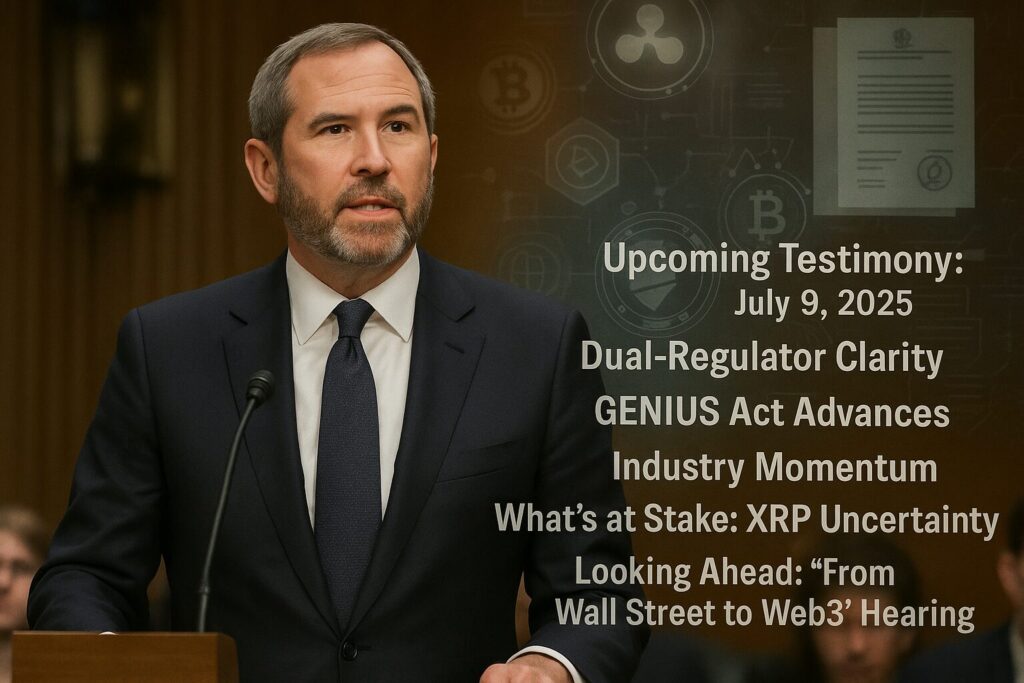
Main Points:
- Upcoming Testimony: Ripple CEO Brad Garlinghouse will testify before the U.S. Senate Banking Committee on July 9, 2025, on crypto market structure legislation.
- Dual-Regulator Clarity: New bills aim to clearly delineate authority between the SEC and CFTC.
- GENIUS Act Progress: Passed the Senate on June 17 by a 68–30 vote, setting uniform rules for payment stablecoins, including full-reserve backing and AML requirements.
- CLARITY Act Advances: Introduced in the House on May 29; advanced by Financial Services and Agriculture committees on June 10.
- Industry Momentum: Major players (Coinbase, Walmart, Amazon) adopting stablecoin rails; Coinbase stock up nearly 19 % in 2025.
- What’s at Stake: Resolution of XRP’s regulatory uncertainty; broader implications for consumer protections and blockchain innovation.
- Looking Ahead: Senate hearing “From Wall Street to Web3” moderated by Senators Scott, Lummis, and Gallego; potential House votes in late summer.
1. Setting the Stage: From Wall Street to Web3
On July 9, 2025, Ripple’s CEO Brad Garlinghouse will join a panel of industry leaders—Summer Mersinger of Blockchain Association, Jonathan Levin of Chainalysis, and Dan Robinson of Paradigm—to testify in the Senate Banking Committee’s hearing titled “From Wall Street to Web3: Building Tomorrow’s Digital Asset Markets.” Ripple’s announcement emphasizes the need for a constructive legislative framework that protects consumers while ushering in a new era of innovation and financial opportunity in the U.S. virtual-asset markets.
“I am honored to testify before the Senate Banking Committee on the need for a sound digital-asset market-structure bill,” Garlinghouse stated in prepared remarks. “Constructive legislation is essential to protect consumers and unlock a new era of innovation.”
(Ripple Press Release)
This high-profile hearing comes at a critical juncture. For years, market participants and regulators have clashed over whether tokens like XRP should be treated as securities (under the SEC) or commodities (under the CFTC). The result: prolonged uncertainty that has chilled U.S. blockchain innovation.
2. GENIUS Act: A Milestone for Stablecoin Regulation
The Guiding and Establishing National Innovation for U.S. Stablecoins (GENIUS) Act (S. 1582) has already passed the Senate as of June 17, 2025, by a bipartisan vote of 68–30.
Key features include:
- Full-Reserve Backing: Issuers must hold 100 % of the stablecoin’s face value in low-risk liquid assets.
- Regular Audits: Mandatory monthly attestations by independent auditors.
- AML/KYC Compliance: Robust anti–money-laundering and know-your-customer safeguards.
- Redemption Rights: Holders can redeem tokens at par value ($1 USD) at any time.
- Congressional Oversight: Exempts the President from certain profit bans, but restricts other members of Congress and their families.
This framework is already spurring commercial adoption: Coinbase’s Payments unit, which enables 24/7 USD-pegged USDC transfers, saw its stock climb nearly 19 % year-to-date, outperforming legacy payment giants like Visa and MasterCard.
3. CLARITY Act: Defining Digital-Asset Jurisdiction
Meanwhile, the Digital Asset Market Clarity (CLARITY) Act of 2025 (H.R. 3633) was introduced in the House on May 29 by Chair French Hill and advanced by the Financial Services and Agriculture Committees on June 10.
Its core objectives:
- Regulator Roles: Clearly assigns “digital securities” to the SEC and “digital commodities” to the CFTC.
- Operational Segregation: Crypto dealers must keep customer funds segregated from their own operating accounts.
- Conflict Disclosures: Mandates disclosure of any conflicts of interest by brokers or custodians.
- Secondary Markets: Incorporates precedent from SEC v. Ripple to clarify that only initial token sales are securities.
Axios notes that industry groups like Stand with Crypto view CLARITY as a “sensible step toward a structured crypto framework.”
4. Timeline of Key Legislative Events
Below is a visual timeline of the bills and hearings shaping U.S. crypto policy in 2025:

5. Why It Matters for XRP and Beyond
XRP holders have watched the SEC’s enforcement action against Ripple since December 2020, and many hope this hearing will finally resolve lingering questions about XRP’s status. A clear market-structure law could:
- End Regulatory Limbo: Provide definitive classification for tokens.
- Boost Liquidity: Encourage U.S. exchanges to relist XRP and other tokens with confidence.
- Stimulate Innovation: Lower compliance costs for blockchain startups.
Beyond XRP, this framework will influence stablecoin issuers, DeFi protocols, and institutional players looking to integrate blockchain technology into mainstream finance.
6. Industry Reactions and Recent Trends
- Institutional Adoption: BlackRock and Fidelity have both filed for Bitcoin ETFs; renewed focus on asset-defense strategies using BTC versus gold.
- Stablecoin Growth: USD-pegged stablecoins now exceed $150 billion in circulating supply ($150 B USD) globally.
- Retail Interest: Major retailers (Walmart, Amazon) pilot stablecoin payment rails with select merchants.
These developments underscore growing confidence in on-chain payment rails and the pressing need for regulatory clarity to sustain momentum.
7. What to Watch Next
- Senate Banking Vote: Possible markup on GENIUS or companion bills in July/August.
- House Floor Action: CLARITY Act could reach the floor as early as September.
- Presidential Decision: President (and family exemption) language may face last-minute amendments.
- International Alignment: EU’s MiCA regime comes into force in late 2025—U.S. law may need to coordinate for cross-border efficiency.
Conclusion
The July 9 hearing marks a watershed moment for U.S. crypto policy. As Brad Garlinghouse and his peers present industry perspectives, lawmakers will balance innovation with investor-protection mandates. If GENIUS and CLARITY both clear their chambers, 2025 could be remembered as the year America finally built a coherent, dual-regulated framework for digital assets—paving the way for the next generation of blockchain applications, from DeFi to tokenized real-world assets.

